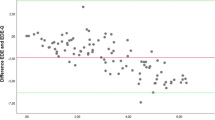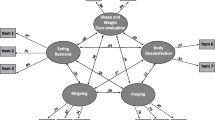Abstract
The purpose of this investigation was to examine the internal consistency reliability and the convergent validity of the Spanish version of the Eating Disorder Examination Questionnaire (EDE-Q) and to provide EDE-Q norms for Spanish undergraduate women. Seven hundred eight college women, aged 18–30 years, volunteered to complete the EDE-Q, BSQ and EDI-2. Satisfactory internal consistency for the four subscales and the global score of the EDE-Q was obtained (Cronbach’s α ≥ .81). The EDI-2 Drive for Thinness and Body Dissatisfaction subscales and the BSQ global factor score correlated highly and positively with the corresponding EDE-Q subscales (r ≥ .72). Average scores, standard deviations and percentile ranks for the raw EDE-Q subscales and data on the occurrence of binge eating and compensatory behaviors are presented. Most of these values were lower than those found in other non-European developed countries. Results support the satisfactory internal consistency and convergent validity of the Spanish version of the EDE-Q. Lower scores in EDE-Q subscales suggest the need to study a lower cut-off point for clinical significance in Spanish college women. These data will help clinicians and researchers to interpret the EDE-Q scores of college women in Spain.
Similar content being viewed by others
Notes
The exception was item 11 (preoccupation with weight and shape), which showed standardized factor loadings above 1. The goodness-of-fit indices of the respecified model when removing item 11 did not improve with respect to those of the initial model: χ 2SB (183) = 1290.95, RMSEA = .093 (CI 90%: .088 to .097), SRMR = .075, CFI = .939, and TLI = .929 (data of the complete results is available from the authors).
References
AERA (American Educational Research Association), APA (American Psychological Association), & NCME (National Council on Measurement in Education). (1999). Standards for educational and psychological testing. Washington: AERA.
APA (American Psychiatric Association). (1994). Diagnostic and Statistical Manual of Mental Disorders (4th ed. revised). Washington: American Psychiatric Association.
APA (American Psychiatric Association). (2000). Diagnostic and Statistical Manual of Mental Disorders (4th ed.). Washington: American Psychiatric Association.
Beglin, S. J. & Fairburn, C. G. (1992). Evaluation of a new instrument for the detection of eating disorders in community samples. Psychiatry Research, 44, 191–201.
Black, C. M. & Wilson, G. T. (1996). Assessment of eating disorders: Interview versus questionnaire. International Journal of Eating Disorders, 20, 43–50.
Carter, J. C., Aime, A. A., & Mills, J. S. (2001). Assessment of bulimia nervosa: A comparison of interview and self-report questionnaire methods. International Journal of Eating Disorders, 30, 187–192.
Cooper, P. J., Taylor, M. J., Cooper, Z., & Fairburn, C. G. (1987). The development and validation of the Body Shape Questionnaire. International Journal of Eating Disorders, 6, 485–494.
Corral, S., González, M., Pereña, J., & Seisdedos, N. (1998). Manual del EDI-2. Inventario de trastornos de la conducta alimentaria. Madrid: TEA.
Decaluwe, V. & Braet, C. (2004). Assessment of eating disorder psychopathology in obese children and adolescents: Interview versus self-report questionnaire. Behaviour Research and Therapy, 42, 799–811.
Fairburn, C. G. & Beglin, S. J. (1994). Assessment of eating disorders: Interview or self-report questionnaire? International Journal of Eating Disorders, 16, 363–370.
Fairburn, C. G. & Cooper, Z. (1993). The Eating Disorder Examination (12th Ed.). In C. G. Fairburn & G. T. Wilson (Eds.), Binge Eating: Nature, assessment and treatment. New York: Guildford Press.
Garner, D.M. (1991). Eating Disorder Inventory — 2. Professional Manual. Odessa (FA): Psychological Assessment Resources.
Garner, D. M. (1995). Assessment of eating disorder psychopathology. In K. D. Brownell & C. G. Fairburn (Eds.), Eating disorders and obesity (pp. 117–121). New York: Guildford Press.
Garner, D. M. (1998). EDI-2: Inventario de trastornos de la conducta alimentaria. Madrid: TEA.
Glauert, R., Rhodes, G., Fink, B., & Grammer, K. (2009). Body dissatisfaction and attentional bias to thin bodies. International Journal of Eating Disorders (doi:10.1002/eat.20663).
Grilo, C. M., Masheb, R. M., & Wilson, G. T. (2001). A comparison of different methods for assessing the features of eating disorders in patients with binge eating disorder. Journal of Consulting and Clinical Psychology, 69, 317–322.
Hollingshead, A. B. (1975). Four factor index of social status. New Haven, CT: Unpublished manuscript, Yale University, Department of Sociology.
Jennings, P. S., Forbes, D., McDermott, B., Hulse, G., & Juniper, S. (2006). Eating disorder attitudes and psychopathology in Caucasian Australian, Asian Australian and Thai university students. Australian and New Zealand Journal of Psychiatry, 40, 143–149.
Jöreskog, K.G. & Sörbom, D. (2004). LISREL version 8.71. [Software for computer]. Lincolnwood, IL: Scientific Software International.
Kalarchian, M. A., Wilson, G. T., Brolin, R. E., & Bradley, L. (2000). Assessment of eating disorders in bariatric surgery candidates: Self-report questionnaire versus interview. International Journal of Eating Disorders, 28, 465–469.
Luce, K. H. & Crowther, J. H. (1999). The reliability of the Eating Disorder Examination-Self-Report Questionnaire version (EDE-Q). International Journal of Eating Disorders, 25, 349–351.
Luce, K. H., Crowther, J. H., & Pole, M. (2008). Eating Disorder Examination Questionnaire (EDE-Q): Norms for undergraduate women. International Journal of Eating Disorders, 41, 273–276.
McDonald, R. P. & Ho, M. H. R. (2002). Principles and practice in reporting structural equation analyses. Psychological Methods, 7, 64–82.
Mond, J. M., Hay, P. J., Rodgers, B., & Owen, C. (2006). Eating Disorder Examination Questionnaire (EDE-Q): Norms for young adult women. Behaviour Research and Therapy, 44, 53–62.
Mond, J. M., Hay, P. J., Rodgers, B., Owen, C., & Beumont, P. J. (2004a). Temporal stability of the Eating Disorder Examination Questionnaire. International Journal of Eating Disorders, 36, 195–203.
Mond, J. M., Hay, P. J., Rodgers, B., Owen, C., & Beumont, P. J. (2004b). Validity of the Eating Disorder Examination Questionnaire (EDE-Q) in screening for eating disorders in community samples. Behaviour Research and Therapy, 42, 551–567.
Passi, V. A., Bryson, S. W., & Lock, J. (2003). Assessment of eating disorders in adolescents with anorexia nervosa: Self-report questionnaire versus interview. International Journal of Eating Disorders, 33, 45–54.
Petersons, M., Rojhani, A., Steinhaus, N., & Larkin, B. (2000). Effect of ethnic identity on attitudes, feelings, and behaviors toward food. Eating Disorders, 8, 207–219.
Raich, R. M., Herrera, S., Rovira, T., & Torres, J. (1997). Evaluación de la imagen corporal en estudiantes universitarias. Cuadernos de Medicina Psicosomática y Psiquiatría de Enlace, 41, 6–14.
Raich, R. M., Mora, M., Soler, A., Avila, C., Clos, I., & Zapater, L. (1996). Adaptación de un instrumento de evaluación de la insatisfacción corporal. Clínica y Salud, 1, 51–66.
Rosen, J. C., Jones, A., Ramirez, E., & Waxman, S. (1996). Body Shape Questionnaire: Studies of validity and reliability. International Journal of Eating Disorders, 20, 315–319.
Rosen, J. C., Reiter, J., & Orosan, P. (1995). Assessment of body image in eating disorders with the body dysmorphic disorder examination. Behaviour Research and Therapy, 33, 77–84.
Satorra, A. & Bentler, P.M. (1988). Scaling corrections for chi-square statistics in covariance structure analysis. Proceedings of the American Statistical Association, pp. 308–313.
Sloan, D. M. (2002). Does warm weather climate affect eating disorder pathology? International Journal of Eating Disorders, 32, 240–244.
Smith, E. & Rieger, E. (2009). An investigation of the effect of body dissatisfaction on selective attention toward negative shape and weight-related information. International Journal of Eating Disorders (doi:10.1002/eat.20703).
SPSS Inc. (2006). SPSS version 15. [Computer program]. Chicago, IL: SPSS, Inc.
Sysko, R., Walsh, B. T., & Fairburn, C. G. (2005). Eating Disorder Examination-Questionnaire as a measure of change in patients with bulimia nervosa. International Journal of Eating Disorders, 37, 100–106.
Villarroel, A.M. (2008). El abuso infantil y su relación con sintomatología alimentaria. Unpublished Doctoral Thesis, Universitat Autònoma de Barcelona, Spain. Retrieved October 23, 2009, from http://www.tesisenxarxa.net/TESIS_UAB/AVAILABLE/TDX-0925109-140414//amvl1de1.pdf
Villarroel, A. & Raich, R.M. (2008). Emotional, physical and sexual abuse as non-specific risk factor for eating disturbances. Oral dissertation presented at the International Conference on Eating Disorders, Seattle. Retrieved November 2, 2009, from http://www.aedweb.org/conference/documents/AEDProceedingsBook08.pdf
Warren, C. S., Cepeda-Benito, A., Gleaves, D. H., Moreno, S., Rodriguez, S., Fernandez, M. C., et al. (2008). English and Spanish versions of the Body Shape Questionnaire: Measurement equivalence across ethnicity and clinical status. International Journal of Eating Disorders, 41, 265–272.
Wilfley, D. E., Schwartz, M. B., Spurrell, E. B., & Fairburn, C. G. (1997). Assessing the specific psychopathology of binge eating disorder patients: Interview or self-report? Behaviour Research and Therapy, 35, 1151–1159.
Wilson, G. T. (1993). Assessment of binge eating. In C. G. Fairburn & G. T. Wilson (Eds.), Binge Eating: Nature, assessment and treatment (pp. 227–249). New York: Guilford Press.
Acknowledgments
This research was partly supported by grant SEJ2005-07099 from the Ministerio de Educación y Ciencia (Spain).
Author information
Authors and Affiliations
Corresponding author
Additional information
Dr. Rosa M. Raich is Professor at the Department of Clinical and Health Psychology at the University Autonomous of Barcelona (Spain). She has published widely on eating disorders and body image and has a special interest on preventive programs in adolescents. She has received several grants to support the study of these fields. In addition, she has developed and/or adapted in Spain several instruments to assess disordered eating and body image disturbances. This paper is part of the thesis dissertation of Dr. Ana M. Villarroel, which was directed by Prof. Raich and Dr. Portell.
Rights and permissions
About this article
Cite this article
Villarroel, A.M., Penelo, E., Portell, M. et al. Screening for Eating Disorders in Undergraduate Women: Norms and Validity of the Spanish Version of the Eating Disorder Examination Questionnaire (EDE-Q). J Psychopathol Behav Assess 33, 121–128 (2011). https://doi.org/10.1007/s10862-009-9177-6
Published:
Issue Date:
DOI: https://doi.org/10.1007/s10862-009-9177-6




